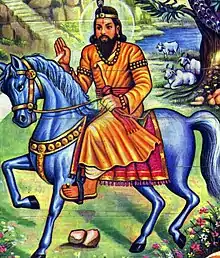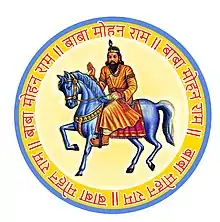Baba Mohan Rama
Baba Mohan Rama (Devanagari: बाबा मोहन राम) is a Hindu folk deity. He is considered by his adherents to be an avatar of the deity Krishna, who appeared during the Dvapara Yuga.[1]: 67
| Baba Mohan Rama | |
|---|---|
 The deity depicted riding his blue horse at Kali Kholi | |
| Affiliation | Vaishnavism |
| Abode | Kali Kholi |
| Day | Dwitiya (द्वितीया ) also known as Doj[1]: 77 |
| Color | Blue |
| Gender | Male |
| Region | Haryana and Rajasthan (especially border regions: Milakpur, Milakpur Gujjar in Bhiwani district; Bhiwadi in Alwar district) |
| Temple | Cave of Baba Mohan Rama, Kali Kholi, Bhiwadi; Milakpur |
| Festivals | Doj Mela, Dhulandi (Holi) |

Iconography
His iconography varies regionally, but he is said to have a gold ring around his head, with a peacock feather holding his dreadlocks, with face resembling Krishna with a glaze of a moon, and a garland made up of pearl and a rudraksha. He rides on a blue horse, who is believed to be the incarnation of Shesha. He is typically shown dressed as a Brahmin, and wearing wooden slippers. He is also featured upon a throne that he acquired from Brahmaloka.[2]
Nomenclature
Baba Mohan Rama's name is derived from the epithets of Shiva, Krishna, and Rama respectively, as he is considered to be a form of the Trimurti. He is attributed as the creator, sustainer, and the destroyer of the universe by his devotees. He is said to have miraculous powers, and his tapasya is meant for the upliftment of people, and providing them a direction to reach liberation (moksha) by being their teacher (guru) in the Kali Yuga. He is supposed to be a descendant of Brahmin pujaris.[1]: 67
Veneration
Baba Mohan Rama's Cave is in the mountain of Kali Kholi, in Bhiwadi, where his akhand jyoti (eternal fire) is present. Devotees come in large numbers during the Doj and the Chemai Doj (Six Month Festival). Devotees offer ghee to his akhand jyoti, which supposedly removes their problems, and they offer bhog and uppla (cow dung cake) to his ever lasting dhuni, which supposedly also cures all the problems caused to his devotees. According to legend, the temple is surrounded by miracles and divine energy, and any service that people do there benefits them, like sweeping the temple floor, donating food to poor, providing water to the bird feeders, and feeding animals, especially cows. The temple is surrounded by trees and birds of various species. It is said that the deity commanded his devotees to build a temple in his name in the village of Milakpur, where his first devotee, Nandu Ji, lived.[2][3][4]
References
- Tyagi, Manu (2018). Shani Mahima Granth. Delhi: Rama Publication. ISBN 978-81-903707-9-0.
- Bhagat Ji, Guru Deshraj (2016). Baba Mohan Ram Katha. Delhi: Baba Mohan Ram. pp. 1–100. ISBN 978-8-5119-3913-2.
- "Bisrakh residents keen to reinstall Ravana idol". Times of India. TNN. 11 August 2016. Retrieved 10 January 2019.
- "Ram makes it in Bisrakh temple, amid heavy police guard". Times of India. 12 August 2016. Retrieved 10 January 2019.
Further reading
- Krishna, Bal (1999). Dooj Vrat Baba Mohan Ram. Alwar: Village Milakhpur Gurjar Bhiwadi. pp. 1–100.